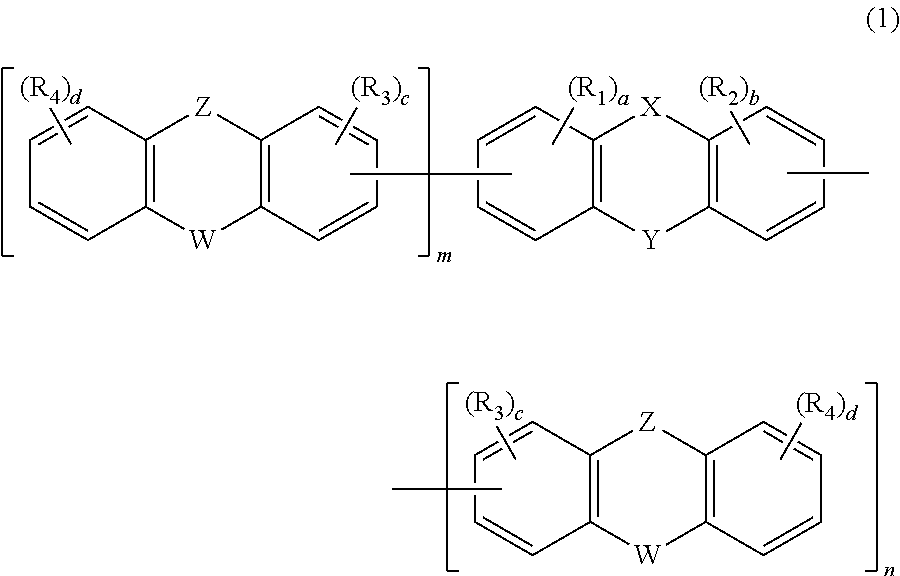Aromatic heterocyclic derivative and organic electroluminescence device using the same
- Summary
- Abstract
- Description
- Claims
- Application Information
AI Technical Summary
Benefits of technology
Problems solved by technology
Method used
Image
Examples
first embodiment
[0139]The organic EL device according to this embodiment has a device configuration in which at least one emitting layer is provided. Specific examples of the configuration are given below.
[0140](1) Anode / emitting layer / electron-injecting and / o -transporting layer / cathode
[0141](2) Anode / hole-injecting and / or -transporting layer / emitting layer / electron-injecting and / or -transporting layer / cathode
[0142](3) Anode / hole-injecting layer / hole-transporting layer / emitting layer / electron-injecting and / or -transporting layer / cathode
[0143]In the specification, the “hole-injecting and / or -transporting layer” means one or both of hole-injecting layer and hole-transporting layer, and the “electron-injecting and / or -transporting layer” means one or both of electron-injecting layer and electron-transporting layer. Unless otherwise specified, the emitting layer includes both fluorescent and phosphorescent emitting layers.
second embodiment
[0144]The organic EL device according to this embodiment has a tandem device configuration in which at least two emitting layers (units having a emitting layer) are provided.
[0145]A carrier generation layer (also referred to as CGL) can be provided between the two emitting layers to provide an electron-transporting region for each unit.
[0146]Specific examples of the tandem device configuration are given below.
[0147]Anode / hole-injecting and / or -transporting layer / fluorescent emitting layer / carrier generation layer / fluorescent emitting layer / electron-injecting and / or -transporting layer / cathode
[0148]Anode / hole-injecting and / or -transporting layer / fluorescent emitting layer / electron-injecting and / or -transporting layer / carrier generation layer / fluorescent emitting layer / cathode
[0149]Anode / hole-injecting and / or -transporting layer / fluorescent emitting layer / electron-injecting and / or -transporting layer / carrier generation layer / fluorescent emitting layer / blocking layer / cathode
[0150]Anode...
third embodiment
[0152]The organic EL device according to this embodiment has a plurality of emitting layers and a carrier-blocking layer between any two of the emitting layers.
[0153]As the preferred configuration of the organic EL device according to this embodiment, there can be given the configurations as disclosed in Japanese Patent No. 4134280, US2007 / 0273270A1 and WO2008 / 023623A1, and, specifically, the configuration in which an anode, a first emitting layer, a carrier-blocking layer, a second emitting layer and a cathode are sequentially stacked, and an electron-transporting region having a blocking layer for preventing diffusion of triplet excitons is further provided between the second emitting layer and the cathode. The carrier-blocking layer is to adjust a carrier balance of the injected electron and hole in the an emitting layer by providing the energy barriers of HOMO and LUMO levels between the carrier-blocking layer and the adjacent emitting layer thereby to adjust the injection of a ...
PUM
 Login to View More
Login to View More Abstract
Description
Claims
Application Information
 Login to View More
Login to View More - R&D
- Intellectual Property
- Life Sciences
- Materials
- Tech Scout
- Unparalleled Data Quality
- Higher Quality Content
- 60% Fewer Hallucinations
Browse by: Latest US Patents, China's latest patents, Technical Efficacy Thesaurus, Application Domain, Technology Topic, Popular Technical Reports.
© 2025 PatSnap. All rights reserved.Legal|Privacy policy|Modern Slavery Act Transparency Statement|Sitemap|About US| Contact US: help@patsnap.com



